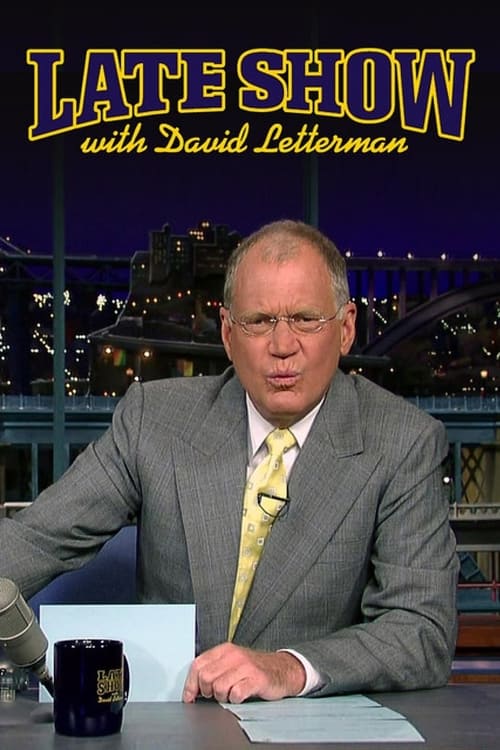Late Show with David Letterman (1993 – 2015)
Late Show with David Letterman
Backdrop for Late Show with David Letterman.
Used for reference and discovery. All rights belong to their respective owners.
Complete episodes, seasons, and air dates for Late Show with David Letterman (1993 – 2015)
|
|
Late Show with David Letterman (1993 – 2015)
Late Show with David Letterman has established itself as a landmark series in contemporary television, redefining what modern storytelling can achieve. Through intricate plotting, layered character development, and innovative narrative structures, the show has captured both popular and critical attention, becoming a cultural touchstone for audiences worldwide. From the very first episode, it challenges viewers with thought-provoking scenarios, moral dilemmas, and emotionally resonant storytelling. Far beyond simple entertainment, Late Show with David Letterman offers a profound exploration of human experiences, relationships, and the complexities of personal growth, leaving lasting impressions long after the credits roll.
The series consistently intertwines themes such as identity, loyalty, justice, loss, and resilience. Every season builds upon the previous one, introducing new conflicts, evolving character arcs, and fresh narrative threads, creating a dynamic story world that is both engaging and immersive. Characters navigate challenges that are emotionally, ethically, and socially complex, inviting audiences to reflect on their own beliefs and values. Pivotal moments blend quiet introspection with dramatic tension, while plot twists and cliffhangers maintain suspense, ensuring that the stakes remain high and the viewer experience is continually compelling.
From a visual perspective, Late Show with David Letterman excels in cinematic storytelling. Every shot is thoughtfully composed, using lighting, color, and framing to communicate mood, character states, and thematic undertones. Production design brings each environment to life, whether depicting intimate domestic spaces or expansive, bustling urban landscapes. The musical score supports and elevates emotional moments without overwhelming the narrative, while direction makes use of silence, negative space, and pacing to emphasize key beats. Together, these elements create a rich, immersive atmosphere that draws the viewer deeply into the story world.
Characterization is where Late Show with David Letterman truly distinguishes itself. The ensemble cast delivers nuanced performances, with lead characters exhibiting moral complexity, emotional honesty, and evolving motivations. Supporting characters are fully realized and play essential roles in driving the narrative forward, often providing pivotal moments of insight, tension, or relief. Relationships develop organically, reflecting realistic dynamics rather than plot-driven contrivances. This attention to character depth ensures that each emotional payoff feels earned, and the audience remains invested in the outcomes of both central and peripheral arcs. Dialogue is carefully crafted, conveying information, emotion, and thematic resonance simultaneously, making even seemingly ordinary conversations carry weight.
Late Show with David Letterman combines clever humor and relatable moments, offering laughter while subtly exploring human relationships and everyday experiences.
For both longtime fans and new viewers, this narrative archive serves as a comprehensive companion to the world of Late Show with David Letterman. It provides episode summaries, thematic analysis, and insights into character development, offering a deeper understanding of the series’ scope and impact. Beyond mere entertainment, Late Show with David Letterman stands as a significant cultural work, one that encourages reflection, sparks discussion, and engages viewers on multiple intellectual and emotional levels. In an era dominated by fleeting content, it remains a memorable and influential example of storytelling craft, inviting audiences to explore, appreciate, and immerse themselves fully in its narrative universe.
| Title | Late Show with David Letterman | |
|---|---|---|
| Genre | Talk, Comedy | |
| First Air Date | 1993-08-30 | |
| Last Air Date | 2015-05-20 | |
| Seasons | 22 | |
| Episodes | 4252 | |
| Runtime | 63 min | |
| Overview | Late Show with David Letterman is an American late-night talk show hosted by David Letterman on CBS. The show debuted on August 30, 1993, and is produced by Letterman's production company, Worldwide Pants Incorporated and CBS Television Studios. The show's music director and band-leader of the house band, the CBS Orchestra, is Paul Shaffer. The head writer is Matt Roberts and the announcer is Alan Kalter. Of the major U.S. late-night programs, Late Show ranks second in cumulative average viewers over time and third in number of episodes over time. The show leads other late night shows in ad revenue with $271 million in 2009. In most U.S. markets the show airs at 11:35 p.m. Eastern/Pacific time, but is recorded Monday through Wednesday at 4:30 p.m., and Thursdays at 3:30 p.m and 6:00 p.m. The second Thursday episode usually airs on Friday of that week. In 2002, Late Show with David Letterman was ranked No. 7 on TV Guide's 50 Greatest TV Shows of All Time. CBS has a contract with Worldwide Pants to continue the show through 2014; by then, Letterman will surpass Johnny Carson as the longest tenured late-night talk show host. |
|
| Stars |
|
|








